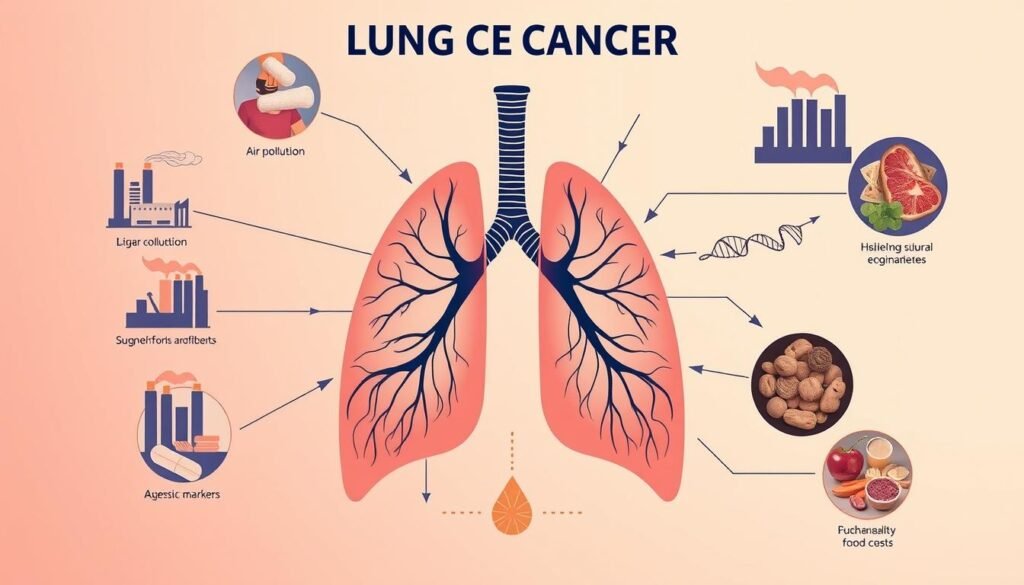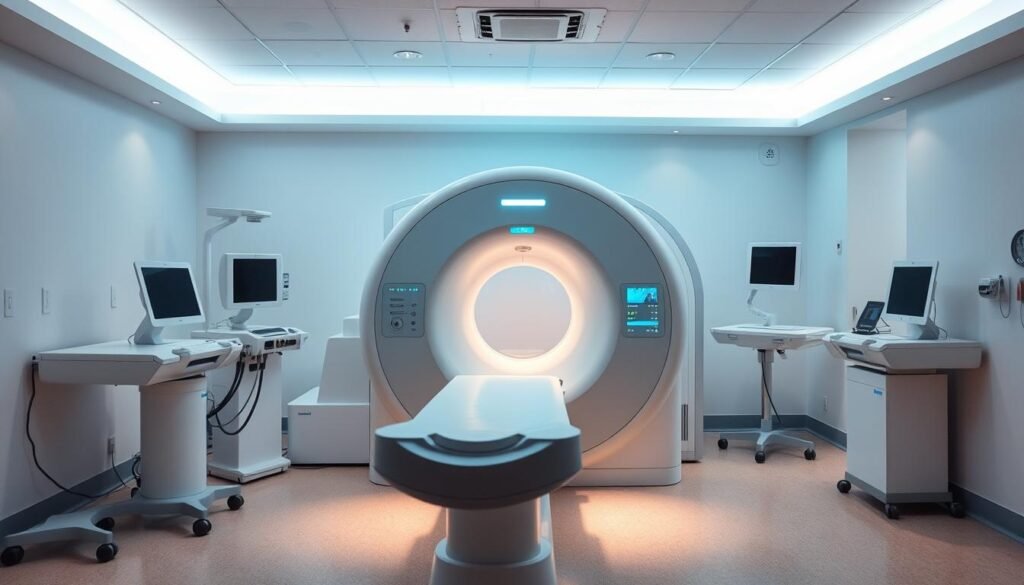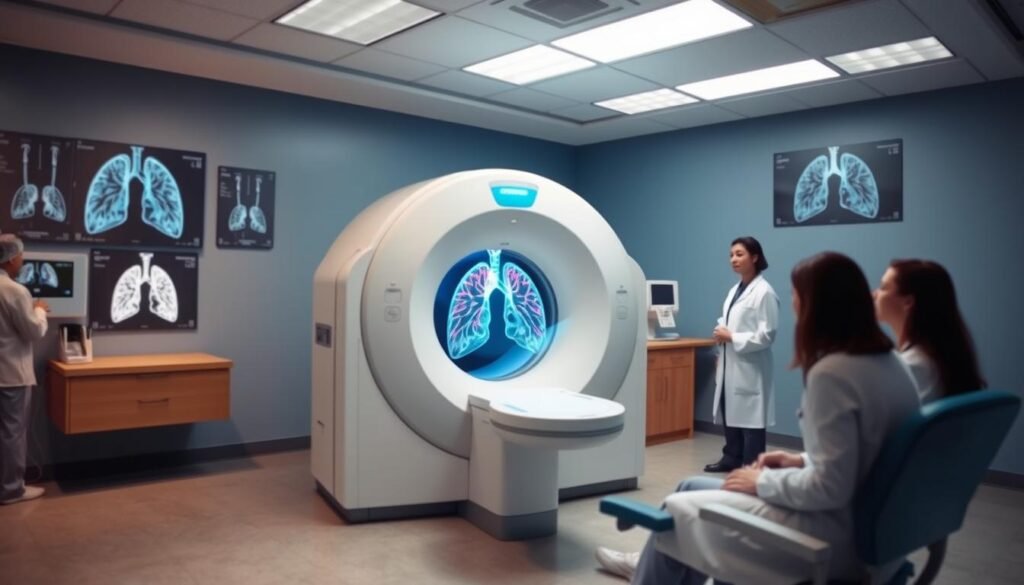Did you know that only 21% of lung cancers are found early, when treatment works best? Early detection is crucial. A CT scan for lung cancer is a key tool for spotting potential problems early. This guide highlights the importance of detecting lung cancer early with low-dose computed tomography (LDCT) for those at high risk.
If you’re 50 to 80 years old and have smoked a lot (20 pack-years or more), please pay attention. This article discusses who should get screened for lung cancer. We’ll cover the benefits and the risks. By knowing about this screening, you can make good choices for your health.
For more info on lung cancer screening, check the CDC’s website. It has guidelines and advice on catching lung cancer early.
Key Takeaways
- The CT scan for lung cancer is essential for early detection in high-risk individuals.
- Screening is particularly important for those with a history of smoking.
- Low-dose CT scans have a radiation exposure roughly equivalent to half of the annual environmental exposure.
- Once detected, small lung nodules may not require immediate action but will be monitored.
- Consultations with healthcare providers are crucial for shared decision-making regarding screening.
Understanding Lung Cancer and its Impact
Lung cancer is a major health concern, impacting many lives. It’s important to know the facts about lung cancer in the U.S. These facts help raise awareness and encourage early action.
Statistics and Prevalence of Lung Cancer
Lung cancer is the top cause of cancer deaths. It claims more lives than breast, prostate, colon, and pancreatic cancers combined. Thousands are diagnosed every year. This shows how important screenings are.
Screenings, especially using low-dose computed tomography (LDCT), are vital. They have lowered death rates from lung cancer. A study with over 53,000 people showed those screened with LDCT had fewer deaths. They did better than those who just got chest X-rays.
Early Symptoms of Lung Cancer
Finding early symptoms of lung cancer can save lives. Yet, they’re often missed until the cancer grows. Look out for persistent coughs, chest pain, and shortness of breath.
- Persistent cough
- Chest pain
- Shortness of breath
- Unexplained weight loss
- Recurring respiratory infections
Knowing these symptoms helps catch the disease early. Talk to doctors regularly if you notice any. For detailed info on early signs, check out this resource.
Lung Cancer Risk Factors
Understanding lung cancer risk factors is essential. Key elements increase the chance of getting this illness. Smoking is the top factor, but other influences matter too. Knowing these can help with prevention and early detection.
Smoking and Its Consequences
Smoking causes about 85% of lung cancer cases. It’s a huge risk, affecting both men and women differently. Smoking a lot over many years increases your risk. Knowing this helps people think about getting checked early. Screenings like low-dose CT scans can find problems early and save lives.
Other Contributing Factors
Smoke isn’t the only danger. Radon gas, asbestos, and polluted air also raise lung cancer risks. Genetics play a part too. Knowing these risks can lead to better health choices and screening decisions.

Lung Cancer Screening: The Importance of Early Detection
Lung cancer is a major health issue in the U.S. Knowing the benefits of lung cancer screening is key for people at high risk. Low-dose CT scans help find lung cancer early. This early detection is crucial to improving chances of survival.
Benefits of Early Detection
Finding lung cancer early can greatly improve treatment success. Sadly, only about 25% of those diagnosed live five years or more. This is often because their cancer is found too late. Catching it early can greatly boost the odds of beating it. Important advantages include:
- Improved Survival Rates: Screening can cut the risk of dying from lung cancer by 20-25% over standard chest x-rays.
- Effective Treatment Options: Early detection means more treatment choices and better chances of success.
- Increased Awareness: It helps people take charge of their lung health, leading to smarter health choices.
Who Should Get Screened?
Some people are more at risk and need to think about screening. The U.S. Preventive Services Task Force suggests yearly low-dose CT scans for:
- People between 50 and 80 years old.
- Those who have smoked at least 20 pack-years.
- Current smokers or those who quit in the last 15 years.
Despite these clear guidelines, only 5.8% of those who should get screened actually do. It’s vital to make screening more accessible and spread the word. This can help find cancers early, improve treatment success, and save lives.
CT Scan for Lung Cancer: Process and Benefits
A low-dose CT scan is key for early lung cancer detection. It uses less radiation than regular scans, making it safer. By understanding the CT scan process, at-risk individuals can make better health choices.
How a Low-Dose CT Scan Works
The low-dose CT scan uses multiple X-rays to create detailed lung images. It spots small tumors better than other methods. With only 1.4 millisieverts (mSv) of radiation, it’s safer for regular screening.

Comparison with Other Imaging Tests
LDCT offers more detail than traditional chest X-rays. Studies show LDCT reduces lung cancer deaths by 20% through early detection. It’s a critical tool for finding lung cancer sooner.
| Test Type | Radiation Dose (mSv) | Sensitivity for Lung Cancer |
|---|---|---|
| Low-Dose CT Scan | 1.4 mSv | High |
| Standard CT Scan | 7 mSv | Moderate |
| Chest X-Ray | 0.1 mSv | Low |
The American Cancer Society suggests yearly screenings for 50 to 80-year-olds who smoked a lot. These scans could save thousands of lives every year. For screening info, check resources by trusted health groups, like the lung cancer screening guide.
Guidelines for Lung Cancer Screening
The field of lung cancer screening is rapidly changing. This is due to new research and health trends. The advice from the American Cancer Society is very important. It helps identify people who need yearly lung cancer checks. It’s key for people at risk to keep up with these guidelines.
Current Recommendations by the American Cancer Society
The American Cancer Society suggests yearly checks for those 50 to 80 years old. This is for people who have smoked for 20 pack-years or more. It includes those still smoking and those who quit in the last 15 years. Talking to a doctor about these screenings can help you understand your risk.
Age and Smoking History Considerations
It’s important to know if you meet the age and smoking rules for these checks. The new guidelines are more inclusive, even if you’ve stopped smoking recently. With smoking being a major cause of lung cancer, identifying those at risk is critical. Below, you’ll find the main points of these guidelines:
| Criteria | Details |
|---|---|
| Age | 50-80 years |
| Smoking History | 20 pack-years |
| Current Smokers | Eligible for yearly screenings |
| Former Smokers | Quit in the last 15 years |
| Screening Format | Low-Dose CT Scan (LDCT) |

Risks and Limitations of Lung Cancer Screening
Lung cancer screening is key to finding and treating cancer early. It comes with benefits and risks. Knowing these risks helps people make smart health choices.
False Positives and Overdiagnosis
Low-dose computed tomography (LDCT) for lung cancer can give false alarms. About one in four people scanned get a result that needs more checks. Often, the findings are not cancer, with over 97% of nodules being harmless. This type of screening can lower death rates from lung cancer by 20%. But, the high chance of false alarms can cause stress and lead to more tests that might not be needed.
Overdiagnosis is also an issue. It might find cancers that wouldn’t have caused problems, especially in older people. This could lead to unnecessary treatment.
Radiation Exposure Concerns
Even though low-dose CT scans use less radiation, having many scans over time is worrisome. Real-life complications from follow-up procedures can be much higher than what studies show. For example, real complication rates are about double what was seen in the National Lung Screening Trial.
Medical costs from these complications can be a lot, from $6,320 for small problems to $56,845 for big issues. It’s crucial to balance the benefits and risks of lung cancer screening.
| Complication Rates | NLST Clinical Trial | Real-world Post-procedure Rate |
|---|---|---|
| Ages 55-64 | 9.8% | 22.2% |
| Ages 65-77 | 8.5% | 23.8% |
Talking with healthcare providers about lung cancer screening is smart. It’s important based on individual health risks.
What to Expect During a Low-Dose CT Scan
Knowing what happens during a low-dose CT scan helps ease worries. To get ready, there are simple steps. You should wear comfy clothes and not eat or drink for a few hours before.
Pre-Procedure Preparation
Telling your doctor about any medical issues or medicine is key. They’ll give you specific prep instructions. This helps get the best images possible from your scan.
During and After the CT Scan
You will lie on a table for the scan, and it takes just a few minutes. It’s needle-free and easy. Right after, you’re free to go back to your day while waiting for results.
This scan quickly gives important lung health info. It can spot problems like lung nodules.
Follow-Up Actions After Screening
After lung cancer screening, the next steps are crucial. First, doctors look at the CT scans carefully. They figure out if the results are normal or not. Normal results mean keeping an eye on the patient’s health. Abnormal results may show lung nodules or other concerns that need more tests.
Interpreting Results
Finding lung nodules on low-dose CT scans happens often. But not all nodules mean cancer. Most are harmless. The size, shape, and density of each nodule are important to decide what to do next.
If nodules are found, doctors will look closely at their features. They might suggest keeping an eye on them or doing more tests. This helps them understand the nodules better after lung cancer screening.
Next Steps if Lung Nodules Are Detected
When lung nodules are spotted, next steps often include:
- Regular scans to watch the nodules over time.
- Biopsies to test tissue samples.
- Surgery if nodules might be cancerous.
Follow-up visits usually happen every 3 to 6 months at first. Then, they may shift to once a year, based on the patient’s health. It’s key to understand the nodules well to read CT scans right.
Conclusion
The evidence shows that early detection of lung cancer is key, especially for those at high risk. Every year, about 160,000 people in the United States die from lung cancer. This makes it clear how important it is to find the cancer early. Low-dose CT scans are better than traditional chest x-rays. They have cut the death rate from lung cancer by 20% by finding the disease early.
Knowing about the scan, its risks, and what to do afterward helps people manage their health. The chance of living more than five years after finding lung cancer early is over 85%. Though low-dose CT scans can sometimes give false alarms, their accuracy in spotting tumors is above 90%. This makes them a good choice for many.
Getting screened regularly can save lives by catching cancer early. Early screening is a big part of winning the fight against lung cancer. By getting screened, people have a better chance of beating the disease and living a long, healthy life.